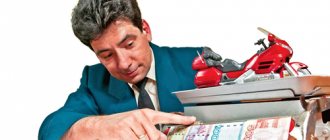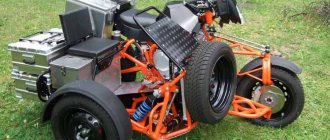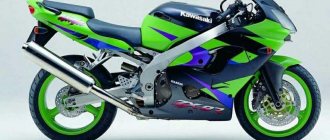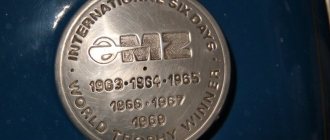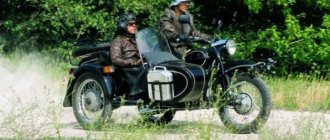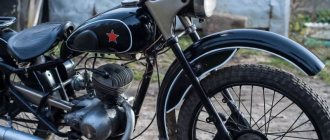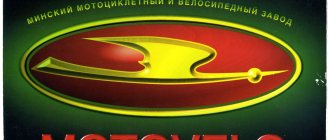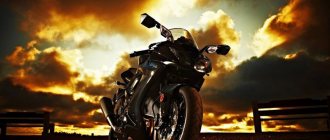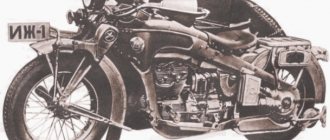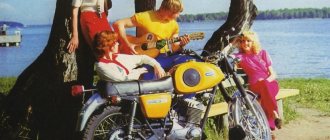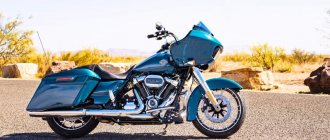The production of motorcycles in Germany began in pre-war times. After the peace treaty was signed, the Germans were prohibited from producing various types of weapons, but motor vehicles were not included in this list. This marked the dawn of the motorcycle industry in Germany. At that time, a car was considered a luxury item, but anyone could buy a regular moped. Companies such as BMW and Zundapp took an active part in the creation of two-wheeled units.
At first, the boxer engine did not stand out in any way against the background of foreign units. However, already in 24, the company independently assembled the first production bike, the BMW R32 . True, the time of motorcycles for general use quickly exhausted its need, and already in the 30s the concern began to produce military motorcycles. The first vehicle specialized in military needs was the BMW R35. This was the first German military motorcycle of the Bavarian company, which had a telescopic fork in front and a 398 cc engine. Low wear and tear during use made this bike indispensable for military purposes. Production lasted about 10 years, after which it gave way to narrow specialization.
In addition to the 35th model, there was also a 12th model. It was an improved version with a larger 750 cc engine. and hydraulic suspension. Removing one carburetor reduced power by 2 horsepower. In 1935, 35 thousand of these units rolled off the assembly line. Low cost and good performance ensured the popularity of this model. In addition, the ability to install the stroller satisfied the needs of many owners. In addition to standard modifications, springs were installed to transport people wounded in battle.
Then the 71st model , which became the basis for the creation of the Soviet Ural and Dnepr motorcycles. The production began in 1938 and was active for a couple of years, after which the unjustification of costs forced the owners to close the project. The equally popular company Zundapp created cheaper bikes with sidecars. Due to their price and maneuverability, they became the basis of the German army's weapons. The most popular model, the K800, was the only model with a four-cylinder engine. This system was rather problematic because it did not provide sufficient cooling to the last two cylinders. This made using the bike for a long time impossible, in addition, the spark plugs often became oily and jammed during operation.
The Great Patriotic War and military motorcycles
German motorcycles of the Second World War consisted of only two models - the BMW R75 and the Zundapp KS750. They performed well off-road and produced good power. Both units had all-wheel drive; we put strollers on the wheel. But the cost of these models did not allow the use of the equipment in Germany. Therefore, all produced equipment was sent from the assembly line to foreign buildings. This continued from 1940 to 1942. Then the decision came to release a modified version of the KS750 with a trailer from BMW . True, the model was never produced in mass production, since the previous order from the state for 40,000 copies of models with a sidecar was not fully completed, stopping at the production of approximately 17,000 mopeds.
Throughout the war, the Germans produced a motorcycle with caterpillar tracks. Such an innovation was surprising not only for opponents, but also for Germany itself. The model was called Kettenkrad and was produced for five years, during which about 8.5 thousand such devices were created. Due to the installed tracks, the bike's cross-country ability in the most difficult conditions was significantly increased. True, when turning, the equipment often turned over, while the driver did not have time to jump due to the difficulties of landing. Moreover, the significant weight of the unit did not allow it to climb the slopes in a diagonal trajectory.
Like all German motorcycles of the Second World War, the Kettenkrad had a large engine with a volume of one and a half liters. True, in appearance such a device was more reminiscent of a small infantry fighting vehicle than a motorcycle. It was convenient to transport people. I was also pleased with the ease of control, albeit with minor shortcomings, but for a bike with such dimensions the idea was very good. The Wehrmacht tracked motorcycle, with all the abundance of iron cover, weighed quite a bit - only 325 kilograms. For a 1.4-liter engine that produced 26 horsepower, such a mass did not cause any particular problems.
German units made a great impression not only on Soviet manufacturers. After the war, many foreign analogues of the BMW R71 model were created. For example, Harley borrowed BMW's four-speed gearbox and driveshaft drive to the rear of the motorcycle.
Motorcycles of Germany.
In 1938-1939, Germany used mainly civilian motorcycles for the army.
For example, take the NSU 201 ZDB, a lightweight motorcycle with a single-cylinder 200 cc two-stroke engine, 7 horsepower and a four-speed manual gearbox. Combinations of heavier motorcycles with sidecars were also used. The NSU 201 ZDB was produced for only about a year, and then the company focused on the production of one of the most unusual motorcycles of the 1939-1945 war - the Kleines Kettenkraftrad Type HK 101, Sd.Kfz 2, or simply “The Kettenkrad”. The history of the hybrid motorcycle known as the Kettenkrad begins with pre-war experiments and continues with the use of this unusual vehicle by the German army on all fronts, from North Africa to Russia. The concept was designed by Heinrich Ernst Kniepkamp in June 1939 and, after some testing, was accepted into production by NSU Motorenwerk as a small crawler motorcycle. At first glance, the Kettenkrad is very similar to a motorcycle, but upon closer examination it turns out that completely different tasks were assigned to it. Rather than serving as a messenger workhorse, the Kettenkrad was used to transport weapons and reconnaissance, along with conventional motorcycles and sidecars.
The first tests showed the Kettenkrad's outstanding off-road capabilities, and even the first modifications of this motorcycle (Sd.Kfz 2/1 and Sd.Kfz 2/2) were already equipped with a special drum device for pulling the field telephone cord. The Kettenkrad could pull a small two-wheeled trailer and was successfully used to transport light anti-tank and anti-aircraft guns. Typically, this motorcycle was used to transport ammunition and food in hard-to-reach areas. On the other hand, there were serious restrictions. The Kettenkrad had excellent cross-country ability, could cover a distance of up to 150 miles on one tank of gasoline, overcome fords up to 18 inches deep, but this motorcycle was controlled from a rather unique position: the pilot’s seat was located between two fuel tanks!
Rider comfort was ensured by a soft, wide sprung seat and rubber interior upholstery that protected the legs from impacts when driving off-road. The Kettenkrad was designed to transport two passengers sitting in the rear jump seats. There were special fasteners for rifles that made it possible to quickly use them if necessary.
However, close examination of photographs of the Kettenkrads revealed several problems with the design, such as the lack of crew protection, which made it an easy victim of shell fragments and light guns. The weakest point in the design was the front wheel and fork. On paved roads everything was fine, but off-road the wheel could simply fall apart. First, to strengthen the structure, the spoked front wheel was replaced with a stamped disc one, and all Kettenkrad drivers were sent an order to replace the wheel without fail.
Of course, the front fork, although it participated in steering, was not the only means for maneuvering. Taxiing was also carried out by tracks, as in tanks, by braking with the left or right track. At the same time, the track braking was also controlled using the steering wheel. This control feature is even written in the operating instructions. At the same time, NSU worked to strengthen the front fork structure.
There was also a pressing issue about training drivers capable of driving the Kettenkrad in off-road conditions. Small radius turns could be made simultaneously by turning the front 19-inch wheel and locking one of the tracks. With some driving experience, the driver could make turns within a 12-foot radius. At the same time, the high center of gravity and not the widest wheelbase made the hair stand on end from such off-road maneuvers! When driving on tarmac, the Kettenkrad made incredible noise, so it only made sense to use it for reconnaissance purposes in hard-to-reach areas. The one and a half liter engine from Opel propelled a fully loaded Kettenkrad on tarmac to a speed of 40 miles per hour. The engine of the pre-war Opel Olimpia was installed on the Sd.Kfz 2/1 and Sd. Kfz 2/2. Some of these beautiful motorcycles survived the war and are preserved in military museums and private collections. They attract genuine public interest every time their engines are revved up at numerous military shows around the world!
The Wehrmacht is also known for its extensive use of sidecar motorcycles. In 1935, BMW began development of the R12 model. The motorcycle was intended for the civilian market and was positioned as a touring bike. The BMW R12 was equipped with a telescopic front fork and a hydraulic rear suspension.
Spurred by innovations in motorsports, the German motorcycle industry was well prepared for the outbreak of war. BMW, DKW and NSU motorcycles performed well in competitions in the 500 cc engine class in the late 1930s. DKW motorcycles dominated the 250 cc engine class. The background to success in the sports arena was the propaganda of Germany as a world leader. In Germany itself, many smaller companies were engaged in the production of motorcycles, and this made it possible to educate a whole generation of experienced motorcyclists and good mechanics.
In 1938, the industry was already purposefully preparing for war. The number of models produced for the civilian market was reduced from one hundred and fifty items to thirty, and the engines of many motorcycles were standardized, so that the same part could fit almost all thirty models. At the same time, many design elements were deliberately simplified. Saddles, license plates, electric horns were brought to a single design. The idea turned out to be successful. By simplifying production, the Army eliminated problems with finding missing parts and repairing equipment.
Like all participants in World War II, Wehrmacht motorcycles had several main distinctive features. Having started the war with a large number of heavy BMW and Zundapp boxer motorcycles with sidecars, by 1944 the Wehrmacht had changed its preference in favor of lightweight 125 cc and 350 cc motorcycles. DKW continued to produce solo motorcycles throughout the war from 1939 to 1945.
In the photos below you will see the completely different motorcycles used by the German army in World War II.
By June 1940 it became clear that nothing would stop the Germans from conquering France. Motorcycles with sidecars equipped with machine guns went into battle side by side with infantry and armored vehicles right up to the coast. A motorcyclist with an Iron Cross on his chest talks to an elderly French woman while the others are waiting for the command's order to advance to Pont-sur-Seine.
Motorcyclists covered in road dust take a smoke break next to their Zundapp K800W after delivering an urgent message on the Eastern Front in 1941. This is one of the official propaganda photographs from the series: “The Army in the Great Struggle for the Liberation of Germany” (“Das Heer Im Grossdeutschen Freiheitskampf”).
A bellboy with a full set of uniforms straps things to his Zundapp DB200W. The gas mask bag, water flask, mattress, side cases and leather map pad on the gas tank are clearly visible. France, 1940.
Motorcyclist messengers dig their Zundapp B800W and sidecar out of the mud on the Eastern Front in the spring of 1942. The stroller is covered with a tarpaulin cover, typical for those years. The pin attaching the spare wheel to the stroller is clearly visible.
May 20, 1940. A messenger military motorcyclist at a rest stop. Motorcycle goggles are pushed down onto his forehead, his face and clothes are black from road dust, and the motorcycle is loaded to the brim with things.
So the A35(t) and military motorcycles pursue the enemy in the spring of 1940 in France. The closest motorcycle to us is the BMW R12 with telescopic front forks.
An abandoned 250cc NSU with a German Afrika Korps helmet attached to the front fork. Remaining fuel and oil flow directly onto the sand.
The convoy rests in the square of Ravia in France on July 19, 1940. Note the waterproof cape of the stroller passenger, the only crew member who had any protection from the rain.
On the Aishne channel July 10, 1940. The narrow paths on both sides of the road were an ideal place for an ambush. The remains of a motorcycle and sidecar lie near a fallen tree, with an abandoned army truck visible in the background.
A typical view of a German-occupied town. Among the general flow of military equipment you will always find BMW motorcycles and 750 cc Zundapp sidecars. Both bikes in this photo are KS600Ws.
Boxer BMW R12 motorcycles with sidecars in Prague with Prague Castle in the background.
The standard crew of a motorcycle with a sidecar consisted of three people and was armed with an MG34 machine gun. The mudguard and sidecar shape are atypical elements for Wehrmacht motorcycles, but the fork design suggests that this is an NSU.
November 11, 1942. A motorcyclist with a child in his arms is surrounded by Bulgarian women in national costumes.
Unrepairable motorcycles of various brands are piled along the road somewhere on the French coast. Motorcycle with sidecar - BMW R75.
German motorcyclists placed a Russian prisoner of war in the sidecar of a BMW R12 motorcycle for further transportation.
SS motorcyclists push their motorcycle and sidecar through tall summer grass in Russia. Note the "SS" marking on the license plate.
Captured German motorcycles aroused the interest of the British army. Here we see a 350cc DKW captured during the advance into Germany.
The same 350 cc DKW. Centrifuge type engine and air filter.
December 15, 1941. British soldiers on a German BMW R75 motorcycle with a sidecar in the vicinity of Tobruk. Note the German Afrika Korps emblem with a palm tree with a swastika on the side of the stroller.
The corpse of a German Afrika Korps motorcyclist near a motorcycle. November 1942.
Captured equipment and weapons were used during military operations. This photograph, taken on July 15, 1944, shows British soldiers with a German Zundapp two-stroke and a local French girl sitting on it. The soldiers, originally from Kent, London and Surrey, are armed with British and German machine guns.
The Turkish cadet sits on a 250cc NSU motorcycle, the logo of which can be read on the gas tank.
Finnish campaign. The skis were used as an experiment, they had several different options for attaching to a motorcycle and were used in countries with snowy winters.
BMW R75
The German tracked motorcycle was not the brightest vehicle of the Second World War. This title rightfully went to the BMW R75 unit. The boxer engine with two cylinders and valves located in the upper part made a splash in the engine industry. The ignition system was equipped with automatic stabilization of the spark advance angle. Despite its considerable weight, the bike was quite maneuverable and passable. In addition, the excellent performance indicators provided by the 750 cc engine. allowed the motorcycle to easily accelerate and pick up speed up to 90 km/h.
The reason for the ease of control was the drive not only to the rear of the motorcycle, but also to the sidecar wheel. Moreover, for comfortable movement in cold climates, the floor of the stroller was equipped with a heating system. The driver was warmed by an air supply system from the engine.
At that time, mobile operations carried out by the German army could not be imagined without this unit. The BMW R75 was in service with various Wehrmacht formations. Everyone rode them - from infantry troops to landing troops.
In addition to excellent cross-country ability, the unit boasted good load capacity. Even with passengers, the device could pull a 450-kilogram trailer, for example, anti-tank installations or mortars. We can say that the BMW R75 is a universal German motorcycle of the 2nd World War. It served not only to transport officers and equipment, but was also used as a communications or reconnaissance vehicle. There were motorcycle companies, consisting of almost 65% of such units.
The device weighed about 660 kilograms with an attached stroller. This made it one of the heaviest motorcycles of its time. Oddly enough, such weight had little effect on cross-country ability. In addition, it was very stable and maneuverable while driving. The fuel consumption was also surprising. In standard configuration, without installing an additional gas tank, the R75 could travel 340 kilometers without refueling.
In conclusion, we can say that the systems installed on German military motorcycles began to be in great demand. Soviet analogues of the BMW R75 are still used in rural areas of our country and even on city streets.
